Tuesday, February 23, 2010
In early December at the Headhouse Square Farmers' Market Beechwood Orchards featured Newtown Pippin apples, a variety that dates to the early 1700s, first found in what is now the New York City borough of Queens.
It is regarded as one of the great storage apples, i.e., it improves with age. And February is regarded as the peak month for its eating. So the other day I pulled one out of the fruit bin of my fridge (stored in a plastic bag with plenty of air holes).
It was superb, and a contradiction of complex flavors: sweet and tart, crisp and tender. It's an apple with depth. Much superior to when I tasted it immediately after purchase. And it stored beautifully, with no soft spots or blemishes beyond those present when picked.
I'll be sure to lay in a supply again next December.
Labels: apples, beechwood orchards, headhouse square, newtown pippin
Sunday, November 22, 2009
Dave Garretson of Beechwood Orchards, who sells at the Headhouse Square Farmers' Market, loves his apples, and this week he had one of the best, the Newtown Pippin.
This variety probably originated in the early 18th century in what is now the Elmhurst area of Queens, New York. (Take the Brooklyn-Queens Expressway and you'll cross Newtown Creek). It was beloved by Thomas Jefferson, Benjamin Franklin, and Queen Victoria.
The Newtown Pippin (unlike my favorite, the Cox Orange Pippin) is one of the great storage apples, which only gets better with age: I plan to delay the gratification of eating them until February, by which time their sugars will be fully formed and balance the tart, piney, citrusy, nutty flavor of this American classic; kept in cold storage with adequate air circulation (a perforated bag in your refrigerator's crisper), they'll probably keep until spring. Eat them now and you'll only get a glimmer of their complexity.
Today it's rare to find Newtown Pippins in the fresh market. Most are turned into juice, thanks to its clear, flavorful nature. If you've enjoyed Martinelli's sparking cider. you've consumed Newtown Pippins. Martinelli's purchases, at above market prices, have prevented the California plantings of Newtown Pippins from being uprooted in favor of other crops.
This revered variety was pushed out of the fresh market over the last 20 years by the Granny Smith, which offers only a hint of the wonders of the Newtown Pippin, but is more visually appealing than the frequently lopsided antique apple, whose countenance can appear marred because of natural russetting near the stem end.
In addition to California, the Newtown Pippin was a favored variety in tidewater Virginia, where the parochials renamed it the Albemarle Pippin, not wanting to keep the Yankee name. It was a major export item to England until the early 20th century when tariffs decimated that market.
Although the Newtown Pippin works well in pies, as well as apple sauce, it's highest uses are for cider and as a dessert (fresh eating) apple
Labels: apples, beechwood orchards, headhouse square, newtown pippin
Sunday, November 15, 2009
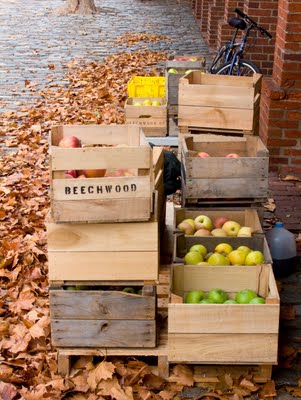 Beechwood Apple Pricing
Beechwood Apple PricingDave Garretson of Beechwood Orchard, who sells at Headhouse Square, has changed his pricing system. Until this week, he priced his fruit by the pint or quart. It was always good value, but you had to take it home and weigh it out to get a good comparison with other vendors.
Starting today he switched to strict by-the-pound pricing. His apples were $2/pound, pretty much in line with other vendors.
And he's still got Cox Orange Pippins.
Dave's only fear is that he's going to have to restrain himself when picky customers threaten to bruise the fruit next peach season.
Labels: apples, beechwood orchards, headhouse square
Sunday, November 08, 2009
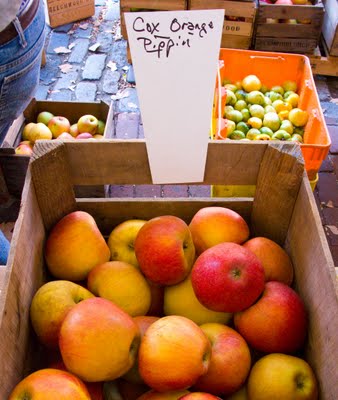 Apple
Appleof My Eye
I've been telling Dave Garretson of Beechwood Orchards about Cox Orange Pippins for a couple of years now. This week he found some on a neighbor's orchard and brought them to Headhouse Square.
Although these apples were picked about a month ago and have been in storage, they've hardly lost anything. Indeed, this variety ripens best after picking. Cox Orange Pippins are only moderately crisp (those who insist on absolutely crunchy crispness will be disappointed), but their flavor is second to none, with a perfect balance of sweetness and tartness. Many believe, as I do, that it's the world's finest dessert apple, i.e., for eating uncooked. It's no wonder that Cox Orange Pippins are the most popular apple in the U.K., so much so that they're imported from South Africa in the off-season. (Alas, because they are more susceptible to disease, it's likely to lose this distinction soon, as more growers shift to other varieities.)
This variety first appeared in 1825 in England. And if you think the taste is vaguely familiar, you aren't imagining it. Today's Gala apple is a less flavorful but hardier descendant.
Labels: apples, beechwood orchards, cox orange pippin, headhouse square
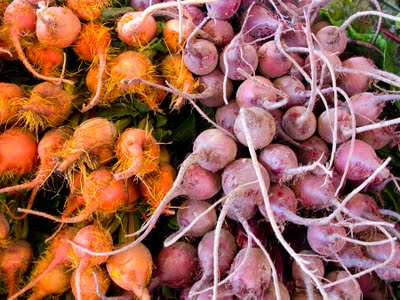
Golden and red beets added color to the Blooming Glen stall at today's Headhouse Farmers' Market.
Labels: beets, blooming glen, headhouse square
Saturday, October 17, 2009
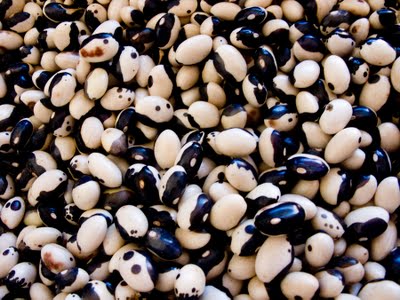 Autumn at Headhouse
Autumn at HeadhouseThese Ying Yang dried beans from Culton Organics are just one of the many varieties of fall produce I found at Headhouse Square Farmers' Market last Sunday.
Tom also featured some delicious, though small, chestnuts. They roasted up perfectly (about 10 minutes in a 425 toaster oven; be sure to make a small 'x' on the flat side to avoid popping). Out of the first two dozen chestnuts I roasted, there were only two that were moldy/inedible.
Brussells sprouts have been making their appearance at local markets, too. Tom was selling his for $5 a quart. His white, purple or orange cauliflower and romanesco was $5 for medium-sized heads. Yellow string beans were $5/quart, sweet potatoes $2/pound. Among fruits, Tom had delicious Winter Banana apples as well as Asian pears; they were pricey at $1 apiece.
Pumpkins, as predicted in a previous post, are expensive this year. Blooming Glen's jack-o-lantern pumpkins were $8 apiece. Long Island cheese pumpkins, ideal for baking use, particularly pies, were $6 each; huge Blue Hubbard squashes were similarly priced. Butternut squash was more reasonable $1.25/pound, Delicata $1.50. Blooming Glen still had field tomatoes last Sunday for $3/pound. Potatoes, both all-purpose and small Russetts (baking) were $2/pound.
North Star Orchards' apples were all $2/pound, except the Honey Crisps, $2.50. Magness pears were $2.
Beechwood Orchards apples were $4/quart, $4.5o for Honey Crisps. Pears were $5/quart, chestnusts $6/quart.
Margarums also had potatoes, including $2/pound Russetts.
Labels: apples, beans, beechwood orchards, blooming glen, brussels sprouds, chestnuts, culton, headhouse square, north star orchards, pears, potato, produce, pumpkins, squash
Sunday, May 03, 2009
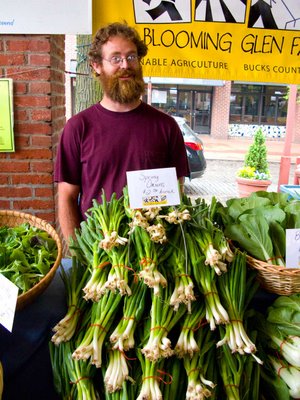 It’s more than nice to see the Headhouse Square Farmers’ Market back for its third Sunday season. It’s reinvigorating. Wow! Now spring is really here.
It’s more than nice to see the Headhouse Square Farmers’ Market back for its third Sunday season. It’s reinvigorating. Wow! Now spring is really here. I counted 28 vendors. Among the produce vendors, you could gather plenty of goodies: all types of spring and over-wintered greens, rhubarb, radishes, mushrooms, scallions (Tom Murtha of Blooming Glen Farm poses with his crop in photo at right), leeks, asparagus and even a few local, though still hothouse, tomatoes. Plenty of seedlings (tomatoes, peppers, eggplant, cucumbers, herbs of all sorts) were available from just about every produce stand, as well as the plant vendors. Tom Culton of Culton Organics featured fennel and fava beans in addition to greens. Plenty of poultry and meat products (frozen) could be had, as well as local cheeses. (I tasted Birchrun Hills Farm’s Alpine variety; it was billed as Emmenthal-like, but I found it more assertive in taste; where Emmenthal is nutty, this was a squirrel’s hoard concentrated into milkfat. I loved it.)
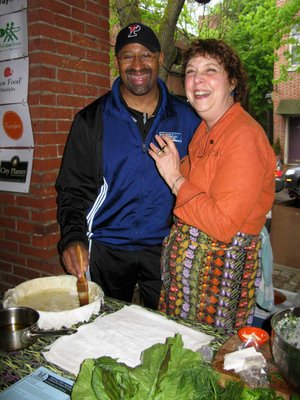 If you gathered up those spring greens, you couldn't do much better than turn them into a Greek-style pie similar to spanakopita, like cookbook author Aliza Green did, with help from local cooking doyenne Betty Kaplan and, briefly, Mayor Michael Nutter (in photo at right with Aliza). Green, who was on hand to sign copies of her many food guides and cookbooks (including her most recent: Starting with Ingredients: Baking), used sorrel, dandelion, mustard greens, dill and whatever other spring greens she could round up (but not kale or collards: too tough and strong for this delicate dish).
If you gathered up those spring greens, you couldn't do much better than turn them into a Greek-style pie similar to spanakopita, like cookbook author Aliza Green did, with help from local cooking doyenne Betty Kaplan and, briefly, Mayor Michael Nutter (in photo at right with Aliza). Green, who was on hand to sign copies of her many food guides and cookbooks (including her most recent: Starting with Ingredients: Baking), used sorrel, dandelion, mustard greens, dill and whatever other spring greens she could round up (but not kale or collards: too tough and strong for this delicate dish).
Nicky Uy, Jon Glynn and Kathy Wich of The Food Trust’s Farmers Market program and the rest of the Trust’s staff and volunteers did a great job in making opening day of the Sunday Headhouse Square Farmers’ Market season a success.
Here’s a full list of the vendors for opening day:
- A.T. Buzby Farm
- Barbi-Lu’s Salso
- Betsy’s Tasty Buttons
- Birchrun Hills Farm
- Blooming Glen Farm
- Busy Bee Farm
- Culton Organics
- Dancing Hen Farm
- Griggstown Quail Farm
- Happy Cat Organics
- Hillcrest Prided Cheese
- Hurley’s Nursery
- Joe’s Coffee Bar
- Longview Flowers
- Marcelle’s Bakery (formerly Versailles)
- Mountain View Poultry
- Natural Meadows Farm
- Queen’s Farm
- Puppy Oove Homeade
- Savoie Farm
- Spring Hill Farms Maple Syrup
- Stargazers Wines
- Sweet Lucy’s BBQ
- Three Springs Fruit Farm
- Wild Flower Bakery
- Weaver’s way
- Yoder Heirlooms
- Young’s Garden
Whole Foods, lead sponsor of the market this year, was there, too, handing out free reuseable shopping bags.
Labels: aliza green, betty kaplan, food trust, headhouse square, mayor nutter
Wednesday, November 05, 2008
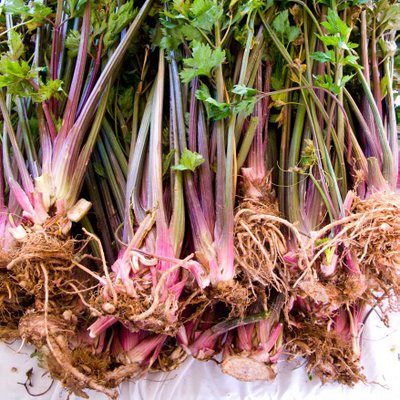 Celery Time
Celery TimeAs Thanksgiving nears, local celery begins to hit area farmers' markets. Here are meter-long samples of red celery found Sunday at Tom Culton's Headhouse Square stall. Soon we'll see blanched celery, which is grown (mostly) under dirt to prevent the stalks from turning green.
Don't limit yourself to raw celery. This red celery, with thin, tough stalks and coarse leaves, is much more suitable for cooking, with a more intense flavor than the common celery. Braised celery (especially the blanched variety) makes an interesting veggie alternative; you can up the interest even more by finishing with some cream. I used the red celery as the major component in a vegetable stock (along with leek, carrrots and a whole head of garlic). Most of that stock is waiting in the freezer, but I used some last night to create an ersatz caldo verde, adding diced carrots, shredded kale and chorizo, but skipping the potato.
Culton recently returned from Slow Food's Salone del Gusto 2008 in Turin, where he was bowled over by everything, but especially the prosciutto produced from a southern Italian breed of goat. Culton hopes to begin raising the breed here. (No doubt Marc Vetri, who travelled to Turin with Tom, would be interested in Culton's animal husbandry.) Because Culton's pulled out his field crops to concentrate on vegetables, he's got the acreage to create room for ruminants to ruminate. Also impressing him was Eataly, the Turin warehouse food emporium inspired by and associated with the Slow Food movement. Culton said the display of various artichokes (a crop he grows here) was as long as the Headhouse shambles.
About that cream . . .
Most of the heavy cream you come across is ultra-pasteurized for a long, stable, boring shelf life. But you can find good, old fashioned regular pasteurized cream, which hasn't been subjected to the flavor-destroying high temperatures necessary for that longevity. It's been a couple of decades since supermarkets sold the regular stuff, but you can find it at Whole Foods and at the Reading Terminal Market (Lancaster County Dairy).
Jonathan Best
The Reading Terminal Market's web site says Jonathan Best, the grocer and soup purveyor, opened this morning.
Labels: celery, cream, culton, headhouse square, jonathan best, reading terminal market, slow food
Monday, October 27, 2008
Based on visits the last two Sundays, Headhouse Square's roster of vendors, though still strong, are fading with the autumn leaves. But there's still plenty of good produce from a variety of farmers to choose from.
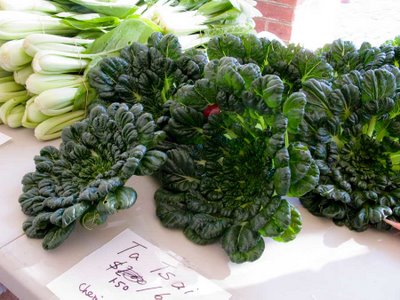 Queens Farm offers a small, selective but unusual array of vegtetables, including these bowl-shaped Ta Tsai greens suitable for use as salad or in cooking, though I can't imagine the latter since it would destroy the beautiful sculpture formed by these lovelies. Better to place of scoop of Asian-inflected chicken or fish salad in the center.
Queens Farm offers a small, selective but unusual array of vegtetables, including these bowl-shaped Ta Tsai greens suitable for use as salad or in cooking, though I can't imagine the latter since it would destroy the beautiful sculpture formed by these lovelies. Better to place of scoop of Asian-inflected chicken or fish salad in the center.North Star had three different Asian pears the last two weeks. I picked up the Hosui variety, which were crisp but incredibly juicy. Five or six varieties of apples were also offered by North Star, as well as at other fruit vendors, including Three Springs and Beechwood Orchard.
Bunches of credibly fresh, thin-bulbed scallions (a.k.a. green onions) were selling for $2 at Blooming Glen at the south entrance to the Headhouse shambles. Queens Farm, meanwhile, had what at first glance appeared to be scallions but upon closer inspection (by the nose) were clearly small bunches of pugent fresh garlic.
A number of the Headhouse vendors will be there on the day before Thanksgiving (Nov. 26). You can order pies, turkey, sides, etc., in advance from them. Griggstown Quail Farm offers Red Bourbon turkeys at $7.99 pound, traditional birds at $3.79.
Labels: autumn, fall, farmers markets, headhouse square
Sunday, October 12, 2008
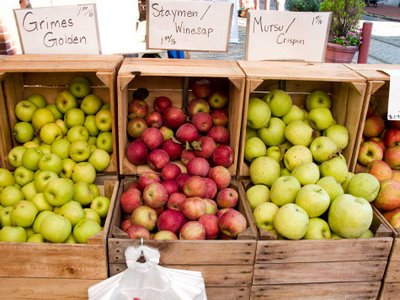
With my store of Cox Orange Pippins rapidly dwindling it's time to resupply. And, just in time, the winesaps are here. These Stayman Winesaps were offered at the Headhouse Square market today by the Wenk family's Three Springs Fruit Farm. Over at Beechwood farms they offered a variety called Turley Winesap. A quick Googling divulged that it was developed in the late 19th century in Indiana. It's apparently not quite as fine a fresh-eating (dessert) apple as the Stayman, but is very good for baked applications. It was particularly important in the early 20th century because of its storage quality and ability to be shipped by rail with little delerious effect.
Over at North Star I picked up a couple each of Golden Russet and Sugar Snap varieties.The former is another fav: a crisp, sweet, medium-sized apple that's a good keeper. So what if it's not red! I haven't tasted the Sugar Snap yet, which has a nice red inflected skin. North Star's website says it's a sweet-tart apple derived from the Empire.
What is it, precisely that separates a common apple from an antique/heirloom variety? That's a discussion I had with Sarah Cain, co-manager of the Fair Food Farmstand yesterday when I noted the sign for the Jonamac's called them heirlooms. Just by its name, I expressed my doubt that the apple qualified, because it's an intentional Jonathan-MacIntosh cross. Sarah contends that even hybrids developed by orchardists qualify fror the "heirloom" nominclature so long as they are 50 years old.
Even on that basis, however, it's hard to justify calling this cross an heirloom or antique. Although the New York State Agircultural Station in Geneva began experimenting with Jonathan-MacIntosh crosses in 1944, a final cross wasn't introduced to the commercial market until 1972, though the strain was largely developed, bred and tested since the late 1950s.
Although I've yet to fine a clear definition of what makes an an apple an "heirloom" or an "antique," my readings suggest that to most people, they mean a variety of apple that was developed introduced prior to the mass shipping by rail of apples in the early 20th century. Apples like the Jonamac, which were developed by government-funded entities after World War II, clearly don't qualify.
An excellent account of the search for heirloom apples under this definition can be found in the November 2002 issue of Smithsonian magazine.
Labels: apples, farmers markets, headhouse square, winesap
Tuesday, August 19, 2008
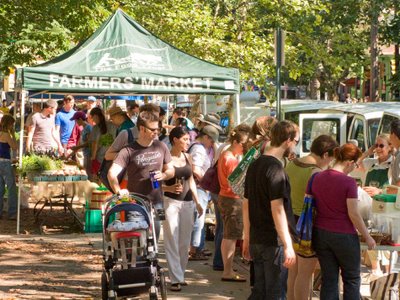 The Clark Park Farmers' Market, sponsored by The Food Trust, will celebrate its 10th anniversary on Saturday, Sept 6. In addition to the market from 10 a.m. to 2 p.m., there will be music and other activities throughout the morning and for a few hours beyond market closing time. In addition to the Saturday market, there's a smaller Thursday afternoon market.
The Clark Park Farmers' Market, sponsored by The Food Trust, will celebrate its 10th anniversary on Saturday, Sept 6. In addition to the market from 10 a.m. to 2 p.m., there will be music and other activities throughout the morning and for a few hours beyond market closing time. In addition to the Saturday market, there's a smaller Thursday afternoon market.I made my first trip since spring to Clark Park and was overwhelmed by the produce offered by about a dozen vendors. You can see a gallery of the photos I took here. Great variety of tomatoes, plenty of summer fruits and veggies of all types. Because I had been to the Reading Terminal Market the day before, the Fairmount market the day before that, and was planning to get to Headhouse the next day, I limited myself to some fresh corn and yellow summer squash. They went great with the loin lamb chops I acquired at Giunta's Prime Shop at the RTM.
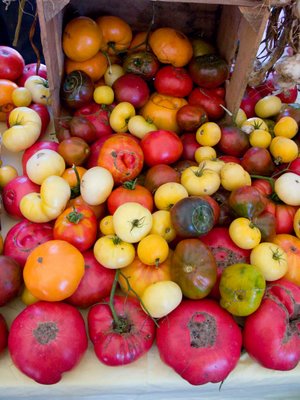 At Headhouse on Sunday plenty of heirloom tomatoes were in evidence at Culton's Organics (photo at right), though I passed these up in favor of their "Currant" tomatoes, tiny little beauties on the vine smaller than "grape" tomatoes. Their highest use is probably just popping them into your waiting mouth, but I used them a quick pasta sauce last night, augmented by just a touch of onion and garlic. Yum. I also picked up some Mirai corn from Culton's, 50 cents an ear.
At Headhouse on Sunday plenty of heirloom tomatoes were in evidence at Culton's Organics (photo at right), though I passed these up in favor of their "Currant" tomatoes, tiny little beauties on the vine smaller than "grape" tomatoes. Their highest use is probably just popping them into your waiting mouth, but I used them a quick pasta sauce last night, augmented by just a touch of onion and garlic. Yum. I also picked up some Mirai corn from Culton's, 50 cents an ear.More Headhouse photos from this week's trip here.
A brief tomato digression. As much as I love the different flavors and characteristics of the various heirloom tomatoes, I certainly don't disparage the basic "field" tomato. Get them ripe off the vine and they not only taste great, they offer a good bargain. And when it comes to picking a tomato for my BLT, I'll pass up the Brandywines, Cherokee Purples and Green Zebras for a good old field tomato, so long as it's ripe and fresh-picked.
And another digression: you can't go wrong in the bacon department for that BLT by getting the Green Meadow Farms product double-smoked by King's Butcher Shop in Paradise, sold at the Reading Terminal by the Fair Food Farmstand. Then again, the applewood smoked bacon available at Harry Ochs works, too. And I've got a package of Country Time's uncured bacon (also from Fair Food) sitting unopened in the fridge which I'm going to try soon.
Over at Fairmount on Thursday I talked with Dwain Livengood, who said he'd be killing some of his chickens over the next week, so they'd be available fresh rather than frozen. The birds are in the 3-4 pound range, and it's best to reserve them. I'll pick up mine this Thursday at Fairmount, but they'll also be available Tuesday afternoon at South Street and Saturday at the Reading Terminal.
Also at Fairmount, Bill Weller is selling some great produce. The cantelope I bought two weeks ago and the watermelon purchased last week were both flavorful and sweet. Last week I also purchased some donut (saturn) variety yellow peaches and turned them into cobbler. Their skins don't peel as easily as regular peaches, even after the hot water/ice water shock treatment, and there's a higher proportion of peel to flesh, so they are probably best used as a fresh-eating peach rather than in cooked and baked applications where you'd want to peel them. Still, even with the extra work and stray pieces of skin, the cobbler tasted terrific.
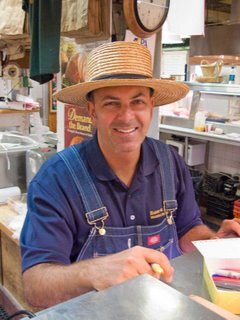 Earlier this month at the Reading Terminal Market's Pennsylvania Dutch Festival, Nick Ochs got into the spirit (photo at left) with some overalls and a straw hat.
Earlier this month at the Reading Terminal Market's Pennsylvania Dutch Festival, Nick Ochs got into the spirit (photo at left) with some overalls and a straw hat.As usual, the festival attracted strong summertime crowds to the market, and the pony cart rarely traversed the block with an empty seat. Bieler's was making donuts in center court, and I tried a hot one as soon as I arrived about 8:30 a.m. Alas, the oil must not have been hot enough: I could have fried a flounder with all the grease this baby absorbed.
Both Iovine's and OK Lee offer local produce as well as the same California, Florida and Mexican imports you'd find at a supermarket (though usually at a lower price). Jersey tomatoes and Pennsylvania corn are among Iovine's offerings, as well as local eggplants, green beans, etc. Finds from further afield recently have included raw peanuts and black figs.
Plenty of local produce can also be found at L. Halteman's and Kauffman's Lancaster County Produce. Benuel Kauffman has expanded across the aisle (photo below) to some of the space formerly occupied by Dutch Country Meats.
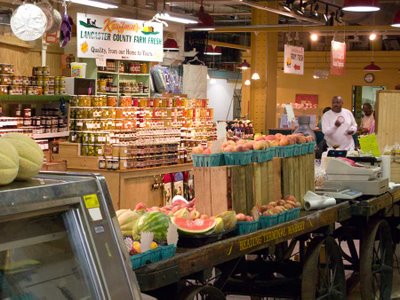
Across the aisle (between 12th Street Cantina and Martin's Meats) is the vacant space once occupied by Natural Connection and, before that, Margerum's. David Schreiber has finally got his financing in place and signed a lease, so work will begin soon on converting the spot to his Jonathan's Best grocery. "The store will carry a wide variety of gourmet groceries and packaged foods, plus pre-made sandwiches, salads and their signature line of soups to eat in or take home. Dave, a native Philadelphia, hopes to open in October," said Paul Steinke, RTM general manager.
Labels: clark park, farmers markets, headhouse square, public markets, reading terminal market
 Robert's Market Report
Robert's Market Report
